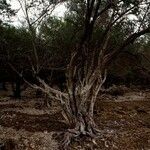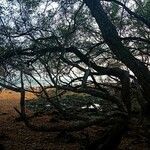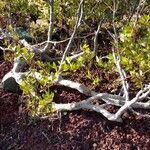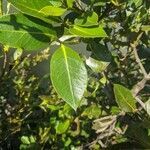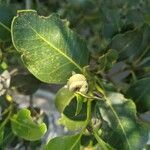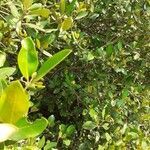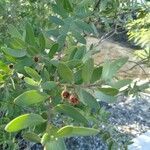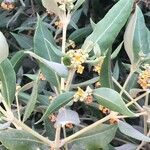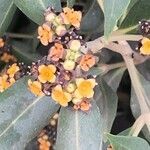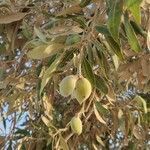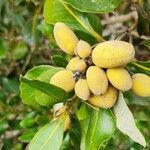Shrub or small tree 1–9 m. tall or even attaining 15 m. when left in favourable conditions; bark brownish yellow-green, smooth.. Pneumatophores 10–25(–40) cm. long. Stems finely grey-tomentose.. Leaf-blades elliptic or ovate-elliptic to elliptic-lanceolate, 3–12 cm. long, 1.5–5 cm. wide, acute to acuminate or even obtuse at the apex, cuneate at the base, green or yellow-green and glabrous above, minutely silvery grey or whitish tomentose beneath, glaucous, sometimes blackening on drying; petiole 3–8(–14) mm. long, gradually passing into the lamina.. Flowers in small dense heads 0.7–1.2 cm. diameter, with 3 heads per terminal inflorescence but lateral branches originating from lower leaflets or leafy nodes; sometimes a pair of additional opposite flowers borne on central peduncle well below the head; bracts and bracteoles ovate or ± round, concave, adpressed to calyx, 2–4 mm. long, 1.5–3 mm. wide, acute, ciliate.. Sepals ovate, elliptic or ± round, 3.5–4 mm. long, 2.5–3 mm. wide, obtuse, ± densely ciliate and tomentose outside.. Corolla yellow, apricot or dark orange, turning black; tube 2–3 mm. long, glabrous; lobes ovate, 2.5–4 mm. long, 2–3 mm. wide, pubescent outside.. Anthers sulphur-yellow turning black.. Ovary yellow-green, narrowly conical, 2.5 mm. long, pubescent above, glabrous below; style 0.8 mm. long, glabrous, 2-fid.. Capsule subglobose, broadly ellipsoid or ovoid, usually not beaked when mature, 1.2–3 cm. long, 0.7–2.5 cm. wide, velvety scaly-tomentose.. Seed usually single, compressed.. Fig. 21.
Tree to 30 m tall, frequently 5–10 m, but becoming a shrub in southern part of its range. Bark white, smooth, flaky or scaly. Pneumatophores to c. 20–30 cm tall. Leaf lamina ovate-elliptic to narrowly lanceolate, 43–164 mm long, 12–49 mm wide; upper surface shiny green; undersurface dull, paler, finely pubescent; tip variably pointed; petiole 3–23 mm long. Inflorescence capitate, of 5–11 decussately arranged flowers, 10–30 mm long. Flowers 4–8 mm long. Calyx lobes ovate, 3–6 mm long, 2–4 mm wide; margins ciliate; apex acute, Corolla actinomorphic; tube 3–7 mm diam.; corolla lobes orange, slightly unequal, 1–3 mm long; outer surface pubescent. Stamens usually 4, ±equal; filaments 0.5 mm long; anthers c. 1 mm long. Ovary conical, densely tomentose above, glabrous below. Fruit compressed ovoid, 14–31 mm long, 11–27 mm wide, 4–10 mm thick; pericarp puberulent; radicle c. 10 mm long, glabrous apart from short densely hairy collar c. 2 mm wide.
Leaves 3.5–12 × 1.3–5 cm, ovate or lanceolate to oblong-lanceolate or elliptic, acute or subacute at the apex, entire with margins slightly revolute, cuneate at the base or ± tapering into the petiole, glabrous or ± obscurely powdery on upper surface, densely pulverulent (powdery)-puberulent or felted-tomentellous on lower surface, coriaceous, usually light green on both surfaces or discolorous and silvery-greyish or greenish-yellow beneath, becoming dark olive-green to blackish above and sordid grey to yellowish beneath on drying; midrib slender and ± prominent on both surfaces, reticulation slightly raised above and obscured beneath; secondary nerves 8–15 on each side of midrib; petiole 3–14 mm long, flattened above, densely powdery-puberulent or tomentellous, rarely glabrescent.
A small tree up to 3-8 m high. It spreads to 2-5 m wide. It often has several stems. It has many slender aerating roots. These are pencil thin and arise from the radiating roots under the surface. The bark is smooth and grey to white. The leaves are 3-8 cm long by 2-3 cm wide. They are oval to sword shaped and shiny grey-green. They are leathery, and whitish underneath. The leaves occur opposite one another. The leaves have a short stalk. The flowers are 0.5 cm across. They are yellowish and have a sweet scent. The occur in the axils of leaves. The fruit capsule is flattened and has 2 large seed leaves. The fruit is edible. There is one seed inside. The seed germinates on the bush before it drops. This species varies a lot. There are some named subspecies.
Shrub or small tree, 2-15 m high, of the mangrove zone; pneumatophores present; nodes swollen. Leaves opposite, simple, lanceolate to elliptic, sessile, entire, coriaceous, peti-olate; stipules absent. Flowers bisexual, regular, small; in contracted or capitate cymes. Corolla 4-or 5-lobed, somewhat fleshy, yellow; tube funnel-shaped or campanulate; lobes longer than tube, ovate, glandular-pubescent on outer surface. Stamens 4, arising in throat of corolla. Ovary superior. Flowering time Aug.-Jan. Fruit a broadly ellipsoid, compressed capsule.
Trunk ± stout, up to c. 25 cm in diameter, sometimes with aerial ‘breathing’ roots (not reaching the ground) on the lower portion; bark smooth and somewhat powdery, whitish or yellow-green; branchlets decussate, slender, subterete or quadrangular, with a densely pulverulent (powdery)-puberulent whitish or greyish thin outer bark, nodes swollen.
Usually a small evergreen tree 3–4 m tall, sometimes to 10(12) m tall, with a much-branched rounded crown and an extensive widely spreading horizontal root system, less often a shrub; roots, particularly in muddy places, giving rise to numerous erect pencil-like pneumatophores, 10–38 cm tall.
Cymes usually solitary in leaf axils towards the end of the branchlets, and usually with 3 at the apex of the branchlets, few-to many-flowered, capitate or subcapitate; the heads 7–15 mm in diameter; peduncles 0.6–4 cm long, quadrangular, sulcate when dry, densely thinly powdery-puberulent.
Capsule 1.2–3 × 0.7–2 cm, subglobose, broadly ellipsoid or ovoid, somewhat asymmetric and abruptly tapering into a short narrow apical beak at least when young, yellowish or pale to greyish-green densely powdery-puberulent, the calyx and involucre persisting unchanged.
Bracts and bracteoles 2–3 mm long, ovate to broadly ovate, concave, obtuse or rounded at the apex, ciliate, glabrous on the inner face, densely silvery-tomentose or sericeous on the outside, finally glabrescent, closely appressed to the calyx.
Corolla white at first, turning yellow or orange to dark orange or reddish-orange, becoming blackish when dry, rigid, caducous; tube 1–2 mm long, glabrous; lobes 3–4 mm long, ovate, densely tomentellous or sericeous outside, glabrous inside.
Calyx green; lobes 2–4 mm long, ovate or broadly ovate to elliptic, rounded at the apex, densely tomentellous outside, fimbriate-ciliate on the margins, persistent.
Filaments erect; anthers subequalling the filaments, suborbicular, sulphur-yellow, turning black.
Seed large, compressed, germinating within the fruit while still on the tree.
Cotyledons reniform, light green.
Flowers fragrant.
